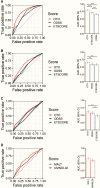Comparison of donor scores in bilateral lung transplantation-A large single-center analysis
- PMID: 33210825
- PMCID: PMC8259697
- DOI: 10.1111/ajt.16402
Comparison of donor scores in bilateral lung transplantation-A large single-center analysis
Abstract
Objectifying donor lung quality is difficult and currently there is no consensus. Several donor scoring systems have been proposed in recent years. They all lack large-scale external validation and widespread acceptance. A retrospective evaluation of 2201 donor lungs offered to the lung transplant program at the Medical University of Vienna between January 2010 and June 2018 was performed. Five different lung donor scores were calculated for each offer (Oto, ET, MALT, UMN-DLQI, and ODSS). Prediction of organ utilization, 1-year graft survival, and long-term outcome were analyzed for each score. 1049 organs were rejected at the initial offer (group I), 209 lungs declined after procurement (group II), and 841 lungs accepted and transplanted (group III). The Oto score was superior in predicting acceptance of the initial offer (AUC: 0.795; CI: 0.776-0.815) and actual donor utilization (AUC: 0.660; CI: 0.618-0.701). Prediction of 1-year graft survival was best using the MALT score, Oto score, and UMN-DLQI. Stratification of early outcome by MALT was significant for length of mechanical ventilation (LMV), PGD3 rates, ICU stay and hospital stay, and in-hospital-mortality, respectively. To the best of our knowledge, this study is the largest validation analysis comparing currently available donor scores. The Oto score was superior in predicting organ utilization, and MALT score and UMN-DLQI for predicting outcome after lung transplantation.
Keywords: clinical research / practice; donors and donation; donors and donation: donor evaluation; lung transplantation / pulmonology; organ procurement and allocation; organ transplantation in general.
© 2020 The American Society of Transplantation and the American Society of Transplant Surgeons.
Conflict of interest statement
The authors of this manuscript have no conflicts of interest to disclose as described by the
Figures




Similar articles
-
The University of Minnesota Donor Lung Quality Index: A Consensus-Based Scoring Application Improves Donor Lung Use.Ann Thorac Surg. 2016 Oct;102(4):1156-65. doi: 10.1016/j.athoracsur.2016.04.044. Epub 2016 Aug 1. Ann Thorac Surg. 2016. PMID: 27492670
-
Outcomes of lung transplantation at a Canadian center using donors declined in the United States.J Thorac Cardiovasc Surg. 2022 Dec;164(6):1661-1668.e1. doi: 10.1016/j.jtcvs.2021.11.098. Epub 2022 Mar 16. J Thorac Cardiovasc Surg. 2022. PMID: 35461711
-
Extended criteria donor lungs and clinical outcome: results of an alternative allocation algorithm.J Heart Lung Transplant. 2013 Nov;32(11):1065-72. doi: 10.1016/j.healun.2013.06.021. Epub 2013 Aug 13. J Heart Lung Transplant. 2013. PMID: 23953918
-
Donor heart and lung procurement: A consensus statement.J Heart Lung Transplant. 2020 Jun;39(6):501-517. doi: 10.1016/j.healun.2020.03.020. Epub 2020 Apr 21. J Heart Lung Transplant. 2020. PMID: 32503726 Review.
-
Organ Donation, the Non-Perfect Lung Donor, and Variability in Conversion to Transplant.Clin Chest Med. 2023 Mar;44(1):69-75. doi: 10.1016/j.ccm.2022.10.005. Clin Chest Med. 2023. PMID: 36774169 Review.
Cited by
-
A Conceptual Model for Sources of Differential Selection in Lung Transplant Allocation.Ann Am Thorac Soc. 2023 Feb;20(2):226-235. doi: 10.1513/AnnalsATS.202202-105OC. Ann Am Thorac Soc. 2023. PMID: 36044711 Free PMC article.
-
Scoring donor lungs for graft failure risk: The Lung Donor Risk Index (LDRI).Am J Transplant. 2024 May;24(5):839-849. doi: 10.1016/j.ajt.2024.01.022. Epub 2024 Jan 22. Am J Transplant. 2024. PMID: 38266712 Free PMC article.
-
Impact of donor organ quality on recipient outcomes in lung transplantation: 14-Year single-center experience using the Eurotransplant lung donor score.JHLT Open. 2024 Oct 11;6:100166. doi: 10.1016/j.jhlto.2024.100166. eCollection 2024 Nov. JHLT Open. 2024. PMID: 40145051 Free PMC article.
-
The Impact of New Treatments on Short- and MID-Term Outcomes in Bilateral Lung Transplant: A Propensity Score Study.J Clin Med. 2022 Oct 3;11(19):5859. doi: 10.3390/jcm11195859. J Clin Med. 2022. PMID: 36233726 Free PMC article.
-
Development and validation of the lung donor (LUNDON) acceptability score for pulmonary transplantation.Am J Transplant. 2023 Apr;23(4):540-548. doi: 10.1016/j.ajt.2022.12.014. Epub 2023 Jan 3. Am J Transplant. 2023. PMID: 36764887 Free PMC article.
References
-
- Foundation EI. Annual Report 2018. In: Samuel PBAU ed. Leiden, the Netherlands: Eurotransplant International Foundation; 2019:15.
-
- Israni AK, Zaun D, Rosendale JD, Schaffhausen C, Snyder JJ, Kasiske BL. OPTN/SRTR 2017 Annual Data Report: Deceased Organ Donation. Am J Transplant. 2019;19(Suppl 2):485‐516. - PubMed
-
- Aigner C, Winkler G, Jaksch P, et al. Extended donor criteria for lung transplantation–a clinical reality. Eur J Cardiothorac Surg. 2005;27(5):757‐761. - PubMed
-
- Botha P, Trivedi D, Weir CJ, et al. Extended donor criteria in lung transplantation: impact on organ allocation. J Thorac Cardiovasc Surg. 2006;131(5):1154‐1160. - PubMed
-
- Thabut G, Mal H, Cerrina J, et al. Influence of donor characteristics on outcome after lung transplantation: a multicenter study. J Heart Lung Transplant. 2005;24(9):1347‐1353. - PubMed
MeSH terms
LinkOut - more resources
Full Text Sources
Medical

